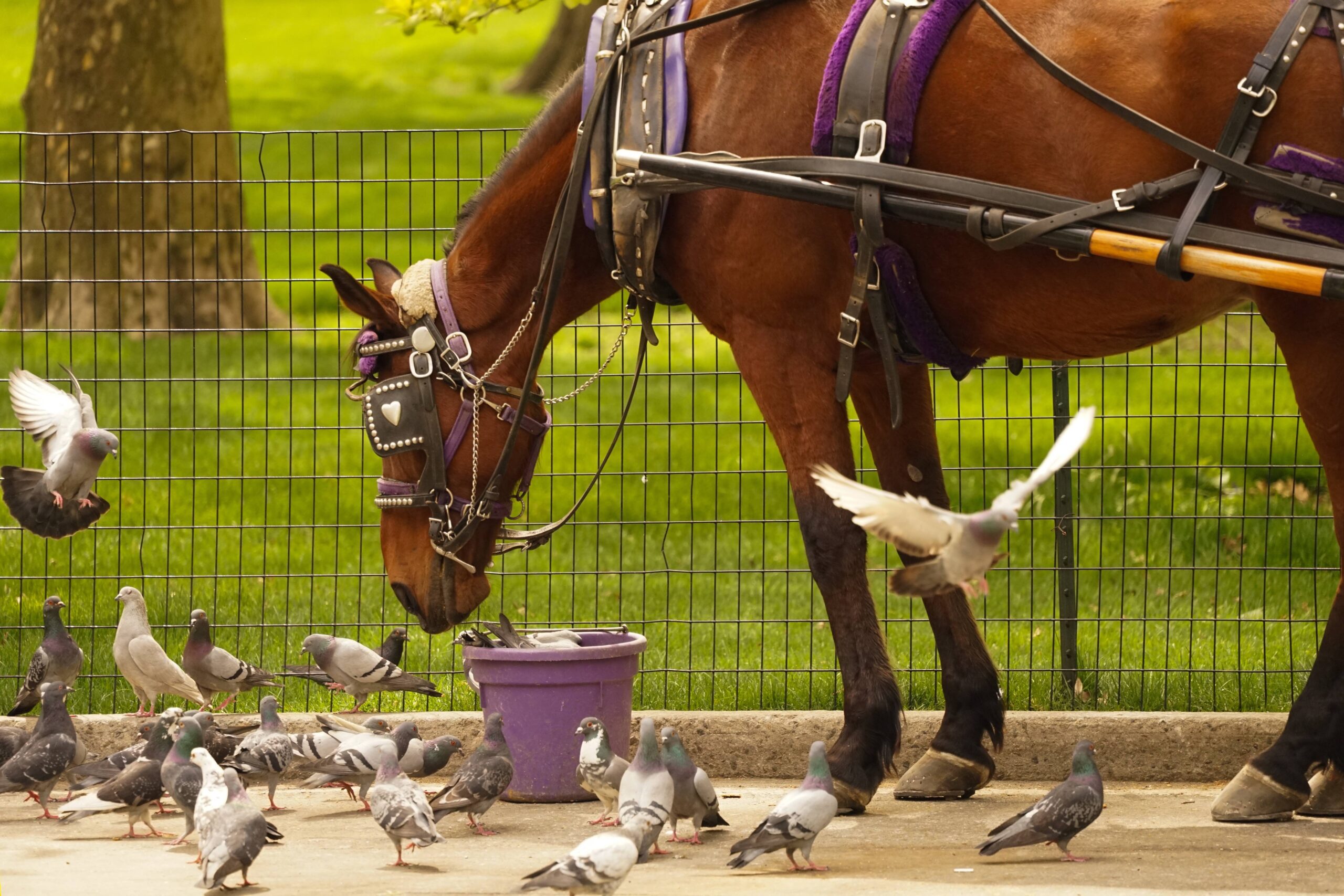Horse-drawn carriages. Dog-walkers. Bodega cats. New York City is teeming with animal life, and not just of the critter variety. While the abundance of animals might be something of a surprise to visitors of the urban jungle, long-time residents might not be fazed by the sight of a dog-walker attached to half a dozen canines.
After all, Dogster.com estimates that there are 600,000 dogs and 500,000 cats in the city, which is “equivalent to one cat or dog for every 8 or so people.”
But what even New York natives might not realize is that, like their fellow humans, some animals in the city today work for a living. (More or less.)
Historically, people usually kept animals for assistance with certain tasks in their daily lives. Horses were used for transportation, oxen for plowing fields, dogs to assist with hunts, cats for eliminating rodents, and so on. For the most part, changes in society and technology have made some of this help obsolete. You wouldn’t expect it if someone asked you for one of your homing pigeons so they can send you letters, for example.
Lamb-scapers
The Basilica of Old St. Patrick’s Cathedral is one of a few places that have gone back to our animal-hiring roots. Each summer, for the past ten summers, three sheep are brought over from a farm over 110 miles away to keep the grounds tidy. There, among the tombstones, they hang out in the yard, eating the grass and alarming unwary passersby.
It began one summer day, when the Basilica’s human lawn mower stopped working.
“The guy who cuts the grass said, ‘I’m going to retire,’” Parish Manager Frank Alfieri told the New York Times. “And the monsignor said, ‘What am I going to do, get sheep?’”
They really did get sheep, though, even giving them church-appropriate names. One year, the grass was gifted with guardians named Gold, Frankincense, and Myrrh; another summer saw the grounds blessed with Faith, Hope, and Charity.
While the sheep can’t be spotted during the winter (as it’s too cold for them), they will make their annual return as soon as the weather warms up this year, said Alfieri.
Taxed Horse Taxis
The topic of animal employment is somewhat controversial, however. Like human jobs, some are more demanding or risk-laden than others. Edita Birnkrant has been outspoken about the treatment of horses in New York City for years, an issue she and her fellow animal rights activists at NYCLASS have repeatedly exposed to the public.
NYCLASS (New Yorkers for Clean, Livable, and Safe Streets) is an animal welfare and advocacy organization. Founded in 2008, the non-profit was created with the mission of “saving NYC carriage horses, enacting animal rights legislation into law, and electing pro-animal candidates to office.” Birnkrant joined NYCLASS in 2017, eventually becoming the organization’s executive director.
According to Birnkrant, many of the horses who drive carriages in the city work in unfair — or even cruel — conditions. Birnkrant has worked hard to make conditions better for the horses, with the eventual goal of eradicating the practice altogether.
“In a brutal heatwave, I documented a horse in respiratory distress,” Birnkrant said. Before her efforts, horses were only required to stop working when the temperature reached 90 degrees Fahrenheit.
“But we all know that humidity, especially in New York, makes it feel so much worse. It could be 85 degrees and feel like 110 because of the humidity.”
In 2019, Birnkrant succeeded in getting the New York City Council to pass the Horse Heat Relief Bill, which legally requires horse drivers to factor in humidity when deciding whether their horses can or cannot work. Now, horses are required to stop working when the combined temperature and humidity on the “equine heat index” — which the New York City Council defines as being “the sum of the air temperature, in degrees Fahrenheit, and the relative humidity at a particular point in time” — is at least 150. (A 90-degree day, with 60% relative humidity, equates to 150 on the equine heat index.)
Canines with 9 to 5’s
Not all zoophilists seek to lay off their furred friends, however. Gilbert Molina III works for Puppies Behind Bars, a group that “trains incarcerated individuals to raise service dogs for wounded war veterans and first responders, facility dogs for police departments, and explosive-detection canines for law enforcement,” according to their website.
The program began 27 years ago, and was originally just meant to teach prisoners how to raise bomb-sniffer dogs. Although the staff size hasn’t grown much since then — “the dedicated staff numbers just fifteen” — the number of potential professions the dogs could end up in has.
And the dogs aren’t the only ones who have gotten something out of the program.
“It brought a lot more light to a dark place, in the prison,” Molina said, who is himself a formerly incarcerated individual and a longtime graduate of this program.
Molina said that prisoners who have signed up for the Puppies Behind Bars program are first screened heavily, in an eight-month process, before they even see a puppy. After being cleared by security, Molina himself interviews would-be owners, to see if they would be a good fit. Then, program members are given an eight-week-old puppy, and for two years are responsible for raising and caring for it. The puppy shares their cell, and only leaves their sight when their owners can’t attend to it (like during a doctor’s appointment), in which case the puppies are cared for by other program members.
“It’s not an easy job to raise a dog,” Molina said.
“Not only do they learn how to train dogs, they learn social skills,” Molina said. “How to take instructions, how to take constructive criticism, how to work as a team, how to take responsibility.”
Once a week, Molina and his fellow instructors go into the correctional facilities and teach the program members how to train their puppies. When the canines reach the age of two (and are technically no longer puppies), they then go on to become guide dogs, service dogs for wounded veterans, comfort dogs for victims at the Manhattan District Attorney’s office, and bomb-sniffing dogs for the police, depending on what kind of job would suit their personalities.
“Some of them are very friendly, so they could go on to become a facility dog,” Molina said, which he explained is a dog who is given to a police department and used for officer wellness and community outreach.
A less friendly dog might be given to someone who experienced something traumatic, and has difficulty going out into public settings.
“These dogs are a little bit less friendly because they’re going to be focused just on the handler, and they perform functions for the owner.”
So next time you want to work as a lawn mower, bomb detector, or carriage-puller, be aware — there might be a four-legged friend with a longer resume than you.



